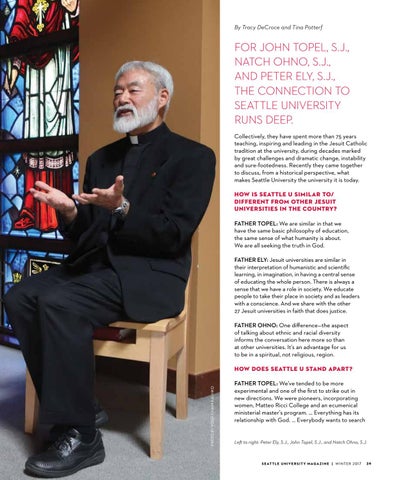By Tracy DeCroce and Tina Potterf
FOR JOHN TOPEL, S.J., NATCH OHNO, S.J., AND PETER ELY, S.J., THE CONNECTION TO SEATTLE UNIVERSITY RUNS DEEP. Collectively, they have spent more than 75 years teaching, inspiring and leading in the Jesuit Catholic tradition at the university, during decades marked by great challenges and dramatic change, instability and sure-footedness. Recently they came together to discuss, from a historical perspective, what makes Seattle University the university it is today. HOW IS SEATTLE U SIMILAR TO/ DIFFERENT FROM OTHER JESUIT UNIVERSITIES IN THE COUNTRY? FATHER TOPEL: We are similar in that we have the same basic philosophy of education, the same sense of what humanity is about. We are all seeking the truth in God. FATHER ELY: Jesuit universities are similar in their interpretation of humanistic and scientific learning, in imagination, in having a central sense of educating the whole person. There is always a sense that we have a role in society. We educate people to take their place in society and as leaders with a conscience. And we share with the other 27 Jesuit universities in faith that does justice. FATHER OHNO: One difference—the aspect of talking about ethnic and racial diversity informs the conversation here more so than at other universities. It’s an advantage for us to be in a spiritual, not religious, region.
PHOTO BY YOSEF CHAIM KALINKO
HOW DOES SEATTLE U STAND APART? FATHER TOPEL: We’ve tended to be more experimental and one of the first to strike out in new directions. We were pioneers, incorporating women, Matteo Ricci College and an ecumenical ministerial master’s program. … Everything has its relationship with God. … Everybody wants to search
Left to right: Peter Ely, S.J., John Topel, S.J., and Natch Ohno, S.J.
S E AT T L E U N I V E R S I T Y M AG A Z I N E | W I N T E R 2 01 7
39
